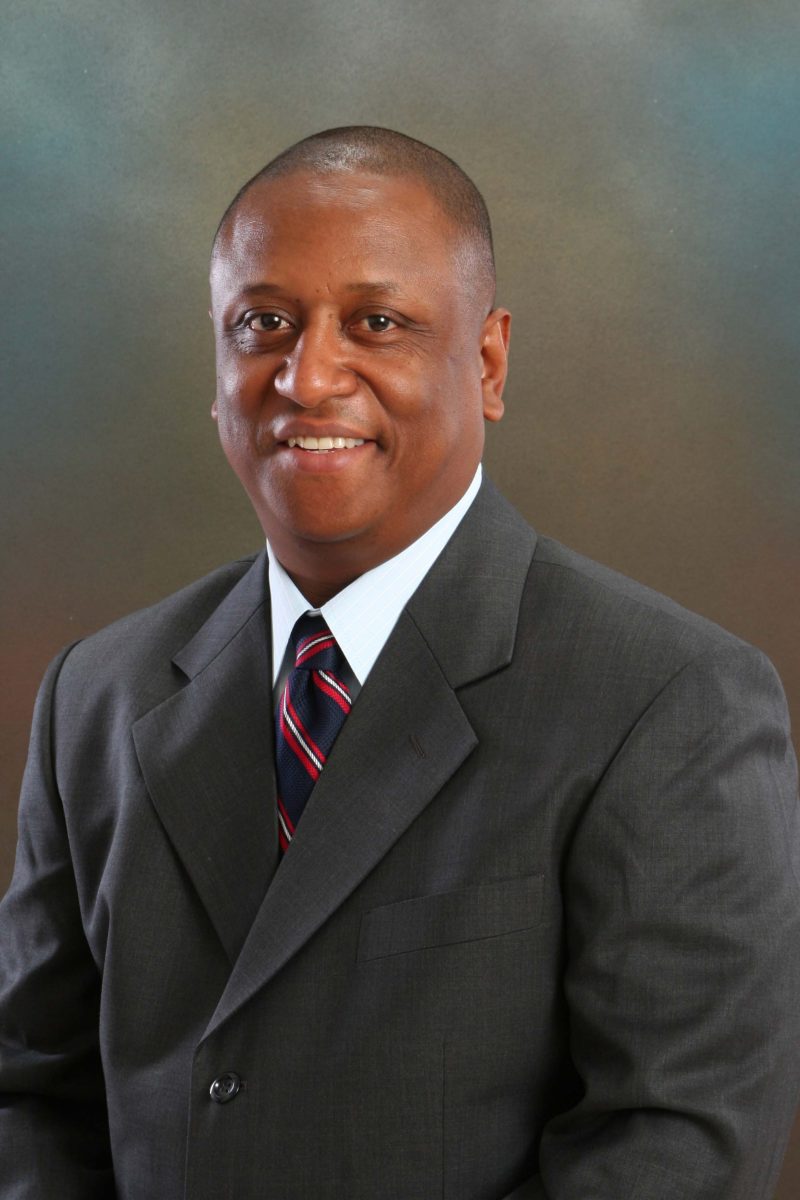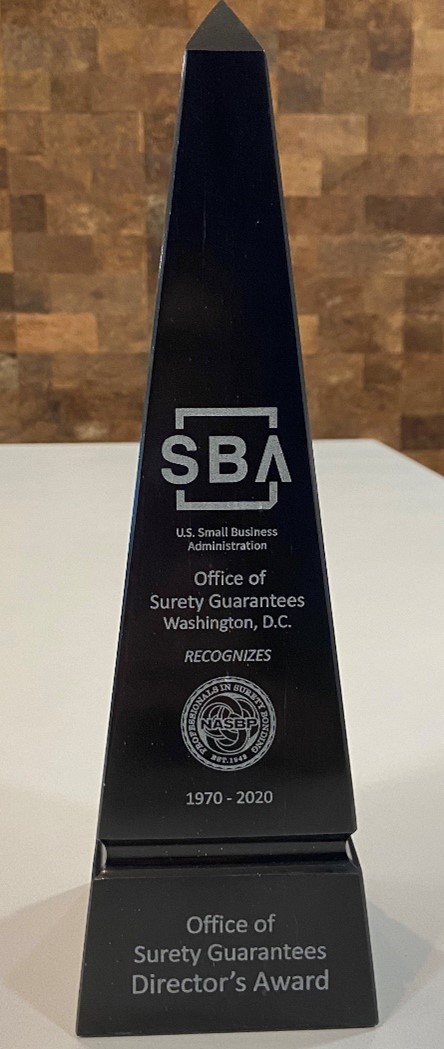NASBP’s commitment to creating opportunities for producer and affiliate members is all about creating win-win scenarios in the economy as a whole. Nowhere is that better illustrated than in the Association’s partnership with the U.S. Small Business Administration’s Office of Surety Guarantees (OSG), led by Peter Gibbs.

That’s because OSG’s mission to provide and manage surety bond guarantees for qualified small and emerging businesses also energizes the producers and surety companies that foster relationships with SBA-qualified contractors. Through OSG’s Surety Bond Guarantee (SBG) Program, the SBA and the surety industry surpassed $7 billion in bond guarantees in FY2020, assisting more than 1,800 small businesses and creating more than 30,000 jobs.
Making this milestone all the more impressive is the fact that it occurred during the SBA’s 50th anniversary of ushering small businesses through the surety process. Since 1970, surety support from the SBA has helped 55,000+ small businesses and protected more than $150 billion in contracts. “The SBG Program enables sureties to help small businesses they probably would not normally assist,” Gibbs said. “That could be because they lack the capital, because they lack the experience, or even because they’re just not really sure.”
But because the program guarantees 80-90% of the losses if a contract issued under its auspices defaults, surety producers are incentivized to create the kind of win-win opportunities that the economy thrives on. “It allows producers to grow their book of business with smaller companies they probably wouldn’t be able to support without the guarantee that we provide,” Gibbs said.
Formalizing a Two-Tier Relationship
Contractors and sureties deal with Gibbs’ Office of Surety Guarantees in two ways, through the Prior Approval Program (also known as Plan A) and through the Preferred Program (Plan B).
Since 1988 the Preferred Program has served as a vehicle for streamlining that interchange. Now with the issuance in January 2021 of a Standard Operating Procedure (SOP) for the Preferred Program, surety companies have formal governance as to requirements and procedures. “In Plan A, every bond we guarantee is approved by an SBA staff member,” Gibbs said. But under Plan B, prior approval isn’t necessary. “The sureties have delegated authority under Plan B: they can go out and issue bonds and get the guarantee from SBA afterward,” Gibbs said.
Guarantee rates for both plans are the same, with the exact percentage depending on the formal status of the business and the size of the contract. Non-federal contracts are capped at $6.5 million and federal contracts at $10 million.
“Whether the company’s an 8(A) firm, a HUBZone firm, a woman-owned business, or a veteran or service-disabled veteran-owned business, it allows sureties to take a chance on these small and emerging businesses and help them get a bond,” Gibbs said. Pictured is the U.S. SBA Director’s Award, which was presented in 2020 to NASBP recognizing NASBP and its members’ work to champion small business.

Any Treasury-approved surety bond company in compliance with eligibility requirements may apply to become an SBA surety partner. Eligibility for the Preferred Program is subject to additional stipulations, with participation then given certainty by the new SOP.
Key Stipulations of the New Preferred Program Procedure
A total of 42 surety companies work with the SBA under the SBG Program–34 under the Prior Approval plan and eight under the Preferred plan (see sidebar for list of Preferred Program participants). Licensed independent surety agents wishing to issue bonds under either SBG program may contact an authorized surety company to instigate a relationship or transaction.
What the new SOP does for Preferred Program participants is establish an unambiguous way forward by cementing the manner in which the surety company interacts with the SBA. “On the Preferred side, a bond producer who has a contractor he or she trying to support would reach out to one of our preferred surety partners and submit that to them,” Gibbs said. “And if the surety company or its underwriter agrees that it’s something that they want to put through SBA, then the surety company will issue the bond, as long as it meets the SBA’s criteria.”
From there, the surety company has 10 days to notify the SBA that the bond has been issued. If all goes well, Gibbs’ office doesn’t get directly involved in the transaction beyond receiving that notification.
The SOP also establishes a structure by which the SBA audits all companies participating in the Preferred Program every three years. “Because we’re delegating decision-making authority on what bonds to guarantee, we go out and visit the companies,” Gibbs said. “The main thing we’re going to look at is whether they’re supporting small businesses based on the size standards established by the SBA.”
Encouraging Small and Emerging Contractors
As executives at Preferred Program surety companies attest, working with Gibbs’ office (through either Plan A or Plan B) helps them fulfill their corporate missions and contribute to economic growth.
“The SBA is a really good tool that we use to help small and emerging contractors that may be reaching a little higher and trying to do a job that’s either just outside their experience capabilities or just outside of what their financials would qualify them for in a traditional surety program,” said Lindey Jennings, Chief Underwriting Officer, Core Surety, at Markel Surety. “It enables us to use bank credit and other financing measures that the contractor may have in place to help qualify for something that’s a little bit larger,” Jennings said. “It helps them grow at a quicker pace than a traditional bond program would.”
Adam Pessin, President and CEO at Tokio Marine HCC Surety Group, sees both plans as offering a path to success for up-and-coming contractors while acknowledging a chief advantage of the Preferred Program. “Both programs are well designed and suited to assist small, emerging, and minority contractors in obtaining surety credit,” Pessin said. “It’s really a choice for the surety in terms of whether it wants to participate in one plan versus the other. The Preferred Program requires less interaction with SBA staff, and it vests underwriting authority with surety employees,” Pessin said.
A Relationship Business
Gibbs, Jennings, and Pessin all agree that benefits also accrue to the surety companies underwriting the bonds and to the producers who facilitate them. In short, working with the SBA helps sureties and producers develop lasting and productive business relationships.
For Gibbs, that means there’s an implication in the process that SBA-assisted contractors won’t spend extended amounts of time in the program. “We offer a way for a surety company to assist a small business in overcoming obstacles in the market,” Gibbs said. “And after being supported by our program for a period of time, the business can graduate into the standard bonding market. It’s a way for the surety company to feel comfortable with the contractor so the contractor can start doing larger jobs that go beyond what we assist with,” Gibbs said.
For Jennings, starting small can produce big results. “We have a saying that we like to use SBA for emerging contractors, not submerging contractors,” Jennings said. “The surety industry’s very much a relationship business, and if you can get in with the contractor early on, give good advice, hook the contractor up with the right CPAs and the right bankers and the right attorneys, and become a valued team member, that relationship can last a lifetime.”
And for Pessin at Tokio Marine HCC, the results can lead to the growth in internal relationships as well. Three distinct group companies comprise the Tokio Marine Surety Group, with two operating under the Prior Approval Program and one under the Preferred Program.
“Cumulatively, I think we’ve been the largest writer in the program for over 20 years; and assisting these small contractors inside and outside the programs is part of our core business,” Pessin said. “We’re perpetually in a position to welcome new producer relationships.”
NASBP: Advocacy for the Surety Industry
Through the efforts of Executive Director Mark McCallum and the Government Relations team led by Larry LeClair, NASBP has been at the forefront of building public/private partnerships through the SBA, advocating for enhancements that have boosted participation among contractors, surety companies, and bond producers.
Meanwhile, NASBP producer members remain in a uniquely advantageous position to increase their own opportunities through the SBG Program. With the new SOP establishing clear procedural and accountability benchmarks for Plan B surety companies, producers stand to find receptivity with top-tier providers whether their relationships are old or new.
“We have underwriters that have relationships with individual producers going back decades, and producers seek out the companies they want to write bonds with,” Jennings said. “But there are always waves of change going on, and that’s where we’ll pick up a new producer.” What’s especially interesting, Jennings notes, is that, for all practical purposes, enhancements to Plan A, in part advocated by NASBP, have made that plan basically as efficient as the Preferred plan.
“They’ve redefined Plan A and made it an invaluable tool in surety again,” Jennings said. “But Plan B definitely has its benefits, especially if you’re dealing with a producer who’s not as familiar with the paperwork. With Plan B, we handle the paperwork.”
As Pessin sees it, no matter how the work gets done, everybody wins. “The SBA is one of the more effective government organizations in terms of what it does to enhance and provide capital to small businesses,” he said. “Surety bonds have played a vital role in that, and we’re happy to have been associated with the agency for almost 25 years.”
Gibbs credits NASBP and its members for the SBG Program’s ongoing success. “We get $6 billion appropriated annually for our program as a whole, and it’s a very healthy program with a very low default rate and a very low loss rate,” Gibbs said. “Something is working, and I would say that it works mainly because of the involvement of the membership of the NASBP, because without the surety producers our program cannot assist small businesses.”
SBA-Authorized Preferred Surety Bond Partners
- CNA/Western Surety Company, Chicago, IL
- Developers Surety & Indemnity Co. (Amtrust/Vista), Irvine, CA
- Indemnity Company of California (Amtrust/Vista), Irvine, CA
- Liberty Mutual Insurance Company (Liberty Mutual Surety), King of Prussia, PA
- Markel Insurance Company (Markel Surety), Austin, TX
- Ohio Casualty Insurance Company (Liberty Mutual Surety), King of Prussia, PA
- Travelers Casualty & Surety Company of America, Hartford, CT
- US Specialty Insurance Company (Tokio Marine HCC), Los Angeles, CA
See www.sba.gov/partners/surety-bond-partners-agents/list-surety-bond-partners for a complete list of SBA Prior Approval and Preferred surety bond partners.
Find Out More
Access a NASBP Podcast on this topic here: https://letsgetsurety.org/episode/12-closer-look-sba-bonding-guarantee-program/. Access free NASBP Podcast episodes here: https://letsgetsurety.org/episodes/. Access a NASBP Virtual Seminar on this topic here: https://learn.nasbp.org/products/the-sba-today-its-not-your-grandfathers-bond-guarantee-program. Access NASBP Virtual Seminars on related topics here: https://learn.nasbp.org/.
 Surety Bond Quarterly Professionals in Surety Bonding
Surety Bond Quarterly Professionals in Surety Bonding
